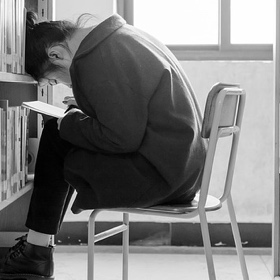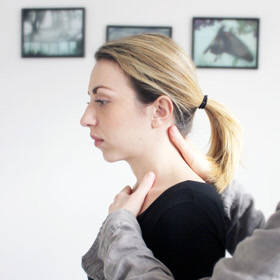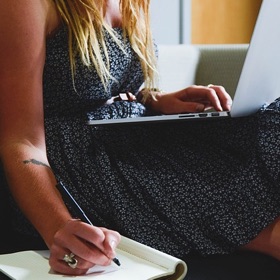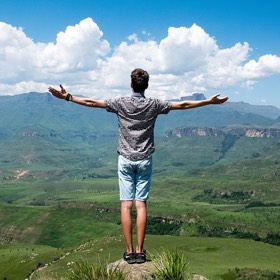What Do You Do When You Feel Pain?
What do you do? Maybe rub it. Maybe pop a pill. Possibly have a little stretch. Or perhaps you have got annoyed by it and act a bit p*ssed off with it. Pushed it away. And pushed on with your deadline and task. Maybe run away from it. Maybe tried to “fix” it.
In fact, You have probably done all of those things at some point. And likely you have tried to act on it more, to solve it, perhaps with yoga or pilates or seen an osteo or physio. Ahh now that can make it feel better for sure.
But then you find yourself having a stressful day, or sleeping funny, or lifting awkwardly, or just putting in a lot of hours in front of the computer, and ping…it pops right back again.
Well perhaps now is the time to take a more thorough look at the dynamics of your every day movement, using a holistic approach that balances science and creativity, and that equips you with skills to not only address the current pain you are experiencing, but also helps you to prevent future injury, and can be applied to work and play, both your physical and emotional life.
When I was thinking about what would be useful for you to hear today, I thought it might be interesting to see if I can convey, perhaps give you a taste or a glimpse of the magic in this approach that connects both mind and body; that addresses both, and therefore how I came to offer this teaching where I incorporate the two aspects through my own experience with pain and the experience of my clients.
 Around 10 years ago I found myself in incredible pain when I was paving a successful career in documentary film and television and reached a point where the pain was so intense and constant that I was forced to stop working. I was accomplished at “pushing through the pain” and it took alot for me to realise that approach was not helping me. I tried many different techniques in attempt to ‘get rid’ of it, or get better, but to no avail – it always came back quite quickly and I was not in control of it, or understanding of it at all.
Around 10 years ago I found myself in incredible pain when I was paving a successful career in documentary film and television and reached a point where the pain was so intense and constant that I was forced to stop working. I was accomplished at “pushing through the pain” and it took alot for me to realise that approach was not helping me. I tried many different techniques in attempt to ‘get rid’ of it, or get better, but to no avail – it always came back quite quickly and I was not in control of it, or understanding of it at all.
So I found myself in agonising pain, mainly Repetitive Strain Injury in my arms and back pain, but to be honest, by the time I “decided” to quit work, the whole of me ached – my whole body, but also much of my mind and soul was pretty tormented by the time I reached this stage (*I emphasise you do not need to get to this point to make a decision to learn to take true care of yourself, that was just my journey – what was required for me to sit up and take notice).
And so, pretty crippled by emotional and physical pain, after trying different techniques, I came across Alexander Technique, which changed my life. I was at a crossroads and could “choose pain and restriction or begin to learn to heal [my]self”, my teacher insightfully said. That woke me up. I’m eternally thankful I chose the latter and went on to do the 3 year full-time training, at a school renowned for it’s stronger emphasis on the connection between psychological and physical experiences. Simultaneously, I met my most profound teacher at a very special meditation and transformation centre called Alchemy (in fact I found Alexander Technique there too), and discovered a space and process for true transformation – the deep inner journey to becoming yourself more fully (a very grounded spirituality, open and accessible to everyone).
And so my training was very much in both these camps. The physical insight grounding the psychological and the spiritual growth, and the latter stretching and deepening the former. It is how I know and understand the work, and it has afforded me so much – my whole life, it feels, as well as my students.
When I began working with people, at first I felt I should separate the different elements (mind, body, soul), and although there was always some connection with our emotional body, I chose to limit my practice to “traditional” Alexander Technique.
Until… I realised I could not help myself! When I was teaching, I knew that this deeper awareness I had come to know that had afforded me so much, would be beneficial for this awesome person in front of me, who had come to me to learn and to explore to the greatest degree they were able. Who was I to limit the skills and the experience for them?
 And so I remember a session with one of my early students who I think was experiencing some leg pain, when I first started to embrace teaching more in this fuller way. In this particular session we were exploring walking. Yes walking! It sounds simple right – we can most of us walk and get from A to B! But how we get from A to B, how we are at A or B, can teach us a wealth of knowledge about ourselves, and despite what some may think, can be a fascinating and fun exploration. Making the ordinary extraordinary.
And so I remember a session with one of my early students who I think was experiencing some leg pain, when I first started to embrace teaching more in this fuller way. In this particular session we were exploring walking. Yes walking! It sounds simple right – we can most of us walk and get from A to B! But how we get from A to B, how we are at A or B, can teach us a wealth of knowledge about ourselves, and despite what some may think, can be a fascinating and fun exploration. Making the ordinary extraordinary.
It is so interesting to explore the things we do everyday that we give little or no thought to, and begin to see if there are habits of tension there, that we are unaware of, that perhaps are no longer serving us.
And so, that day, it was simply walking. And standing. Walking and standing. And I noticed my student was subtly gripping her toes – as if they were gripping onto the floor. It was just a flat ordinary wooden floor. There was nothing to grip onto. No need to grip. And I had a flashback of discovering, in my training, I too had had that same habit! And for me it had led to a pretty big insight, that has waves of repercussionary insight even til this day – in many different aspects of my life – as my teacher at Alchemy would often say, the micro is a reflection of the macro.
And so, rather than just highlighting the physical habit (or encouraging her to discover it for herself), I decided to broaden our exploration of awareness, and decided to dip my toes (so to speak) by sharing with her my experience those years previous.
I told her, I once discovered I grip my toes. And I found in fact I was “gripping on for dear life” (I love how language really can reflect the deeper meaning of physical experiences). As if gripping my toes, holding on, was saving me, enabling me to be here – to stand, to walk, or just to be upright. And so I chose to explore, and to let go. And woah, to keep my toes there, just resting, and not gripped, felt like the most vulnerable thing I could do! That may sound crazy, but when we find a metaphorical golden nugget, as this was for me, unexpected feelings are often the case. In this vulnerability, I discovered that my toes were not trusting the floor to support my very being; I was not trusting my toes, my feet, my body to support me. Bigger than that, I was not trusting life! Woah. That was quite a brain explosion, for me. For me, it hit a real point of truth. I had been embodying distrust – in my toes! Distrust of the moment, of myself, and even, as my insight progressed, distrust in life. And, of course, not just there in my toes, but the whole of my body, at that point being highlighted by my toes. Seeing that, opened me up to the possibility of trust, and embodying that trust – and woah that feels different. That changes everything.
This process is all about Awareness – in all directions and in all forms: of mind, of body and of soul. It is all  connected. And my experience is, that by consciously opening to those connections, is where the true gifts of a deeper, fuller healing lie.
connected. And my experience is, that by consciously opening to those connections, is where the true gifts of a deeper, fuller healing lie.
And so, back to the session, with my student, and I gently got her to notice what she was doing with her toes. And it completely surprised her – she had had no idea. I shared my experience and insight and we explored together the fullness of her experience, and I saw how it afforded her a much greater depth of insight, with far more width and breadth. With guidance, she was able to see what it was she was doing to contribute to that, uncover the root of it for her, and open to a new way of moving, thinking and being, with greater freedom and lightness.
And so, perhaps the biggest take-away from this, is to remember that your pain is often the lighthouse to a deeper transformation. Quite subtly, perfectly, but uncomfortably at times, drawing your attention to an opening, a potential, an invitation. The pain, the discomfort is perhaps the crack to let the light in, to allow fresh fertile ground to emerge.
*I hasten to add, not everyone will resonate with this specific habit or insight, and that is perfectly okay and valid – everyone is unique, and every experience is just as important (you don’t have to share my previous habits of holding tension to work with me and get to the individual root of your pain, and the benefits that that may bring you). I would also add, importantly, to know this is not a race, you have not missed out – there is no urgency or deadline. All is brought to our attention in perfect timing.
From then on I gradually and quite naturally began to weave in and develop further the process for working with these different elements, and I continually see and hear from brave students, of all different situations, how substantially this holistic approach has supported their own process of coming to greater wellbeing, as it has me.
Working with a student who had injuries from a car crash 20 years previous, was a truly humbling experience as I witnessed her regain significant use of her arm that she had long abandoned and written off, as well as supporting her emotional processing of the trauma of the original incident all those years ago, and that she been holding onto since.
 Sessions with a super busy successful lady who came to me with sciatica, we uncovered one of the layers, that for her was the huge stress of her work had her disengaged with her body and her feelings. In fact she discovered she was un-grounded, emotionally and physically. And grounding her in her body, in her legs fully, allowed her to also “stand up” for herself under stressful conditions at work, which gradually transformed her experience of it.
Sessions with a super busy successful lady who came to me with sciatica, we uncovered one of the layers, that for her was the huge stress of her work had her disengaged with her body and her feelings. In fact she discovered she was un-grounded, emotionally and physically. And grounding her in her body, in her legs fully, allowed her to also “stand up” for herself under stressful conditions at work, which gradually transformed her experience of it.
A man who came to me wanting to address his posture, and discovered the under-confidence he was holding in himself, and where that stemmed from. As his awareness deepened over the course of sessions, not only was he able to move in a different way and develop a healthier and more open posture, but he saw changes in how he was at work, how he felt and expressed himself socially, as well as in his performance hobby of acting.
The more that we see ourselves, meet ourselves in awareness and get to the root, the more we are able to open to new experience – greater ease, peace, and embodied wellbeing.
These approaches so naturally complement eachother. When we build our awareness on all these levels – mind, body and soul – and the interaction of these different parts, as I saw with my students and experienced for myself, we become more alive, and are  able to make more sense of the work. This combined exploration helps people to understand how to apply this work to their everyday – ultimately to create lives that are healthier, happier, more nourishing, and in which they feel able to be themselves more fully in every moment and experience.*
able to make more sense of the work. This combined exploration helps people to understand how to apply this work to their everyday – ultimately to create lives that are healthier, happier, more nourishing, and in which they feel able to be themselves more fully in every moment and experience.*
Important to know that nothing is ever forced or pushed beyond what you are able for. I take great care to create a safe space to meet you exactly where you are, whilst also gently highlighting and encouraging an opening, at the right time.
I am genuinely so lucky and grateful to share this work with the amazing people that come to me, ready – perhaps apprehensively – but open to this awesome exploration, and the journey we take together. I have found both Alexander Technique and Embodied Wellbeing so nourishing and healing for myself, and I continue to. I am honoured everyday to be a witness to the transformation, big and small, that I see in others.
If you are feeling that call and readiness to begin to explore, then I invite you to schedule a free 20 minute consultation phone call, with no obligation, to find out if this experience is right for you. I am open to all questions and I look forward to hearing from you soon! I am here for you.
Address the Core and the surface of your pain.
Discover Alexander Technique & Embodied Wellbeing
Email Sarah now to arrange a complimentary 20 minute Wellbeing Consultation call to see if and how this work could support you.
Or visit her page right here